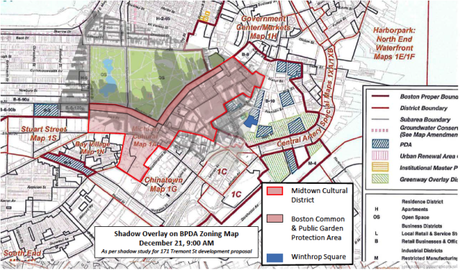Two State laws in place for the past quarter of a century have effectively protected Boston's signature public parks from excessive shadowing, while still allowing for robust downtown development. The Friends of the Public Garden steadfastly supports these effective laws and opposes any erosion of these protections.
● This State law restricts new shadows on the Common to the first hour after sunrise or 7:00 a.m. (whichever is later) or the last hour before sunset, with different exemptions for buildings in the Midtown Cultural District, which lies east and south of the Common and Garden (see the attached plan).
● For buildings in the Midtown Cultural District, new shadows are allowed for no more than two hours between the hours of 8:00 am and 2:30 pm from March 21 to October 21. Any new shadow lasting two hours or more during these times is not allowed, but the law authorizes the BRA (now BPDA) to grant exemptions.
● The law created a "Shadow Bank" in the Midtown Cultural District of one acre from which the City can allow developers to "withdraw" for shadows cast for longer than the two-hour exemption, above. These new shadows can last for longer than two hours only if the "Shadow Bank" is not depleted. The acreage in the Bank is calculated from March 20, 1989.
● Just under .25 of an acre is all that remains in the Shadow Bank today.
* For the Millennium Winthrop Square site, which is outside the Midtown Cultural District, the proposed project may cast new shadows on the Common for one hour after sunrise or 7:00 am, whichever is later, or the last hour before sunset.
* For the Millennium Tower at Filenes on Washington Street, which is in the Midtown Cultural District, the building casts new shadows on the Common for less than two hours and is in compliance with the Shadow Law.
* For the Millennium Ritz development on Avery Street, which is in the Midtown Cultural District, the buildings cast new shadows of more than two hours. The City permitted the developers to make a withdrawal from the shadow bank of .72 of an acre, in compliance with the Shadow Law.
● This law restricts new shadows on the Public Garden to the first hour after sunrise or 7:00 a.m. (whichever is later) or the last hour before sunset.
● For buildings in the Midtown Cultural District, new shadows are allowed before 10:00 a.m. during the period between March 21 and October 21.
Both laws also set shadow limits for buildings in Planned Development Areas approved on or before May 1, 1990. In addition, the Common law establishes limits for the South Station Economic Development Area. The current proposal for South Station is in compliance with the Shadow law.
● A zoning ordinance adopted by the City of Boston in 1989 provides additional protection for the Boston Common and Public Garden from excessive shade by setting a height limit of 155' throughout the Midtown Cultural District. The Midtown Cultural District is the area abutting the Boston Common and Public Garden from Arlington to School Streets and generally defined by Boylston, Tremont, and Washington Streets.
● In addition, it created a special Protection Area within the District - the Boston Common and Public Garden Protection Area - for buildings along Tremont and Boylston Streets. Height limits in this Area range from 125' - 155' along Tremont Street and from 85' - 130' along Boylston Street.
Boston Common & Public Garden Protection Area Winthrop Square

